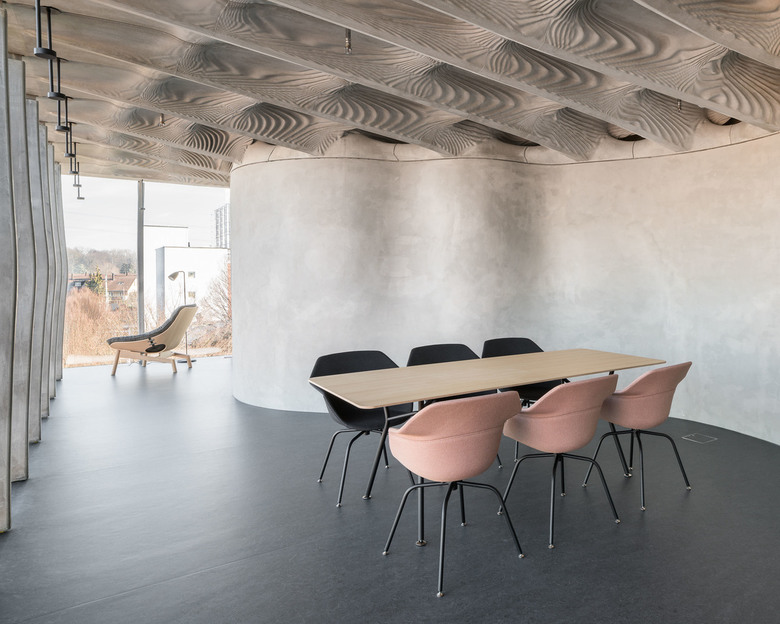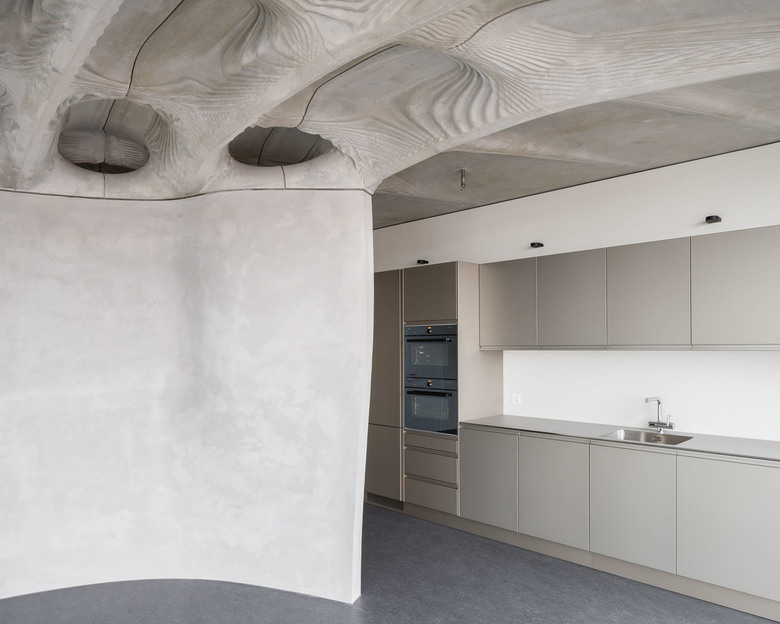Building Digitally, Living Digitally
ETH Zurich, NCCR Digital Fabrication
11. de novembre 2019
Photo: Roman Keller
Seven professorships at ETH Zurich under the banner of NCCR Digital Fabrication came together to take digital planning and construction methods out of the lab. Matthias Kohler and Konrad Graser answer our questions about the DFAB HOUSE.
Location: Empa, Überlandstrasse 129, 8600 Dübendorf
Client: Swiss Federal Laboratories for Materials Science and Technology (Empa)
Architecture
Concept: Prof. Matthias Kohler, Konrad Graser
Design and project management: Konrad Graser (Lead), Marco Baur, Sarah Schneider
Contributors: Arash Adel, Dr. Aleksandra Anna Apolinarska, Prof. Dr. Benjamin Dillenburger, Dr. Kathrin Dörfler, Rena Giesecke, Prof. Fabio Gramazio, Dr. Norman Hack, Matthias Helmreich, Andrei Jipa, Prof. Matthias Kohler, Dr. Ena Lloret-Fritschi, Dr. Mania Aghaei Meibodi, Fabio Scotto, Demetris Shammas, Andreas Thoma
Photo: Roman Keller
What is special about the project?DFAB HOUSE marks the first time that a full scale, inhabited multi-storey building has been designed and built using advanced digital fabrication methods including robotics. The project is the result of a nationwide interdisciplinary research initiative in Switzerland, called NCCR Digital Fabrication, aimed at transforming the design and building process by integrating computational design and digital fabrication into architecture. Its design concept is based on leveraging the full architectural potential of selected novel digital building processes in the field of robotic fabrication and 3D printing technologies through integrated processes. To realize DFAB HOUSE, researchers at seven ETH Zurich professorships came together with industry experts and planning professionals in a unique way to demonstrate and test how digital fabrication can change the way we design and build. The design of the DFAB HOUSE leverages six research innovations: the In situ Fabricator, a versatile autonomous on-site construction robot; Mesh Mould, a formwork-free, robotic process for steel-reinforced concrete structures; Smart Dynamic Casting, an automated concrete slip-forming process; Smart Slab, integrated ceiling slabs fabricated with 3D-printed formwork; Spatial Timber Assemblies, a robotically fabricated timber structure; and Lightweight Translucent Facade, a membrane skin filled with translucent thermal insulation.
Photo: Roman Keller
What is the inspiration behind the project?The project is the result of an interdisciplinary Swiss research initiative, the National Center of Competence in Research (NCCR) Digital Fabrication. The NCCR Digital Fabrication aims to revolutionize design and construction processes through the integration of digital fabrication techniques.
DFAB HOUSE combines six structural innovations: In situ Fabricator, an autonomous construction site robot; Mesh Mould, a formless robotic process for construction of free-form, in-situ concrete structures; Smart Dynamic Casting, an automated slipform system enabling production of objects with variable cross-sections; Smart Slab, an integrated, optimized concrete slab prefabricated using 3D-printed formwork; Spatial Timber Assemblies, a robotically prefabricated wood module construction; and Lightweight Translucent Facade, a lightweight membrane facade with translucent aerogel high-performance insulation.
Photo: Roman Keller
Were there significant changes from the first design to the completed building?The design concept of the DFAB HOUSE makes use of the architectural potential of the integration of selected novel digital construction technologies, such as robotic fabrication and 3D printing, into the planning process. Its architecture is the expression of a collective vision based on an intensive exchange between architects, engineers, computer scientists, materials experts, sustainability specialists and contractors from industry and trade. To achieve this, a decidedly open, collective design process was necessary, with the design constantly adapted over a long period of time - for example, to respond to new findings or advances in research and development in the individual digital construction processes. The result was an informed architecture that reflected the essential qualities of the digital manufacturing processes, i.e. how the building was created.
Photo: Roman Keller
Did the location have influence on the project?Along with its unique design and construction, the location of DFAB HOUSE plays a key role in the project. The house is situated on top of Empa’s NEST building, the skeleton of a vertical city wherein individual research “units” are designed, built and occupied. This experimental location allowed the architects of DFAB HOUSE a completely free reign to build however they saw fit, removing the usual barriers between experiments in the lab and real-world construction sites.
Photo: Roman Keller / NCCR Digital Fabrication
Which role does DFAB HOUSE play in the contemporary discourse?DFAB HOUSE is the world's first multi-story habitable building to be both designed and built using several completely new digital design and manufacturing methods. The realization of DFAB HOUSE is the result of a unique collaboration of researchers at seven ETH Zurich professorships with over 40 industry partners and planning experts to jointly demonstrate and test how digital fabrication could change the way we design and build.
As an architectural project, DFAB HOUSE has no direct role models, but has predecessors in the multiple prototypes and demonstrations that have been realized at ETH Zurich in recent years as part of research on digital construction processes. Accordingly, the project and architecture team was put together from scratch, specifically for the DFAB HOUSE project.
Photo: Digital Building Technologies (dbt), ETH Zürich / Tom Mundy
Did current debates influence the project and its trajectory?Sustainability was a focus during design and construction at DFAB HOUSE. Through tailoring each element to its conditions, the material savings were significant. In fact, the Smart Slab alone offers 65% weight reduction as compared to traditional slabs, and Mesh Mould is a formwork-free, zero-waste application that also uses an optimized, intelligent shape to minimize material use. The architecture of DFAB HOUSE leverages digital fabrication to make tailored designs economical, while exposing all structural elements of the building in their true materiality, producing varied and tactile spaces rather than dull repetition.
Photo: NCCR Digital Fabrication
Which product or material was key in the success of the project?In this sense, no one product or material was key in the success of DFAB HOUSE, moreover a combination of new digital techniques, enabling a completely unique vision.
The ground floor of DFAB HOUSE is designed to be a shared space. Characterized by floor to ceiling windows supported by 15 bespoke, curved concrete mullions, the centerpiece of the room is the Mesh Mould wall, an S-shaped structure providing natural shared and hidden spaces to the house’s inhabitants. The non-standard, curvilinear wall provides load-bearing support for the undulating Smart Slab, a geometrically complex structure, forming the ceiling. Traveling up to the second and third floors of DFAB HOUSE, visitors are transported from the clean yet organic lines of the ground floor to the feel of a contemporary Alpine chalet on the residential second and third floors. Split into four standalone apartments, robot-built Spatial Timber Assemblies provide a warm, homely feel and catch the eye with their non-uniform placement, while the lightweight translucent facade made with Aerogel ensures that natural daylight penetrates the outward facing walls, while also providing inhabitants with privacy and thermal comfort.
This article originally appeared as "Building digitally, living digitally" on Swiss-Architects.
Articles relacionats
-
Building Digitally, Living Digitally
11/11/19
-
How Robots Build a House
16/9/19







